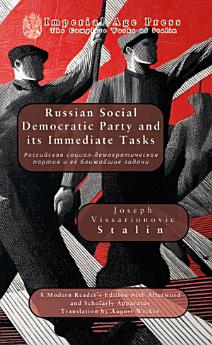Russian Social Democratic Party and its Immediate Tasks
About this ebook
This essay was first published in late 1901 by the party press (printed in the Caucasus) when Stalin was on the Bolshevik editorial staff. It laid out how small, local economic protests were giving way to mass political action, and therefore the Party needed to prepare for an uprising. Its core message was that isolated strikes or demands (for higher wages, shorter hours) were useful tactics but not the ultimate goal. Only when the “entire working class goes forward to storm its enemy as a single, organized force” could victory be won. Stalin insisted that the Social-Democratic Party must actively lead and arm the proletariat, moving beyond mere propaganda to concrete preparation for revolt.
Politically this tract was important as an early attempt to mobilize the Bolsheviks around revolutionary activism. It was printed in a clandestine party organ in 1901 (later appearing in Stalin’s collected works) and helped frame the Party’s approach to the 1905 Revolution. Historians note that Stalin here echoed Lenin’s insistence on disciplined leadership, while also conveying his own emphasis on mass coordination. The essay had limited circulation at the time (in Russian among Social-Democrats), but it was later cited as evidence that Stalin recognized the need for cohesive working-class action even before Lenin’s full campaigns began. In Soviet retrospect it was often cited to show Stalin’s early alignment with the insurrectionary spirit of Bolshevism, setting a precedent for his later focus on organized armed struggle.
This modern Critical Reader’s Edition includes an illuminating afterword tracing Stalin's intellectual relationships with revolutionary philosophers and politicians (including Hegel, Feuerbach, Engels, and Ricardo), containing unique research into his intellectual development and economic-metaphysical theories, religious impulses masquerading as materialism, a comprehensive timeline of his life and works, a glossary of Lenin-Stalinist terminology, and a detailed index of his work works. Combined with the scholarly amplifying material, this professional translation is an indispensable exploration of Stalin’s world-changing philosophy which he manifested into one of the most terrifying authoritarian regimes ever created.






